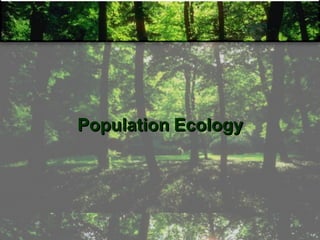
population ecology
- 2. Core Concepts 1. Five important characteristics of a population are its geographic distribution, density, dispersion, growth rate, and age structure. 2. Three factors can affect population size: the number of births, the number of deaths, and the number of individuals that enter or leave the population. 3. The biotic potential of an ecosystem is affected by environmental resistance, thus resulting in a maximum carrying capacity. 4. Factors that limit population growth include both density-dependent (ex. competition) and density- independent (ex. natural disasters) factors. 5. Understanding patterns in human population growth is important in addressing population problems around the world. 7/28/2011 Free PowerPoint Template from www.brainybetty.com 2
- 3. Keywords • geographic distribution/range • population density • population dispersion • immigration • emigration • logistic growth • exponential growth • biotic potential • environmental resistance • carrying capacity • density-dependent factors • density-independent factors Free PowerPoint Template from www.brainybetty.com 3
- 4. What is a population? A population is a group of individuals of the same species occupying the same general area. Characteristics of a Population 1. Geographic distribution 2. Density 3. Dispersion 4. Growth rate 5. Age structure
- 5. Geographic distribution - geographical range of a species or a group of species - the suitability of habitats influences the distribution of a species (each species is adapted to a rather limited range of abiotic and biotic conditions) Population density - the number of individuals per unit area or volume
- 6. Population dispersion - pattern of spacing among individuals in a habitat Types of dispersion: RANDOM - habitat conditions are uniform / resource availability is steady - individuals neither attract nor avoid each other - rare in nature UNIFORM - individuals are evenly spaced in a habitat - due to competition or territorial behavior CLUMPED - species are aggregated in patches - most common in nature because: cluster around patchy resources live in social groups species has limited dispersal powers
- 7. Growth rate - increase in the size of a population of organisms population size the number of individuals that contribute to a population’s gene pool
- 8. Estimating Population Size: CAPTURE-RECAPTURE Method For mobile animals Individuals are captured and marked in some way, then the marked animals are released. Later, animals are captured and checked for marks. In the later sample, the proportion of marked individuals should be representative of the proportion marked in the whole population.
- 9. Growth rate - increase in the size of a population of organisms population size the number of individuals that contribute to a population’s gene pool Factors that affect population size: 1. Number of births 2. Number of deaths 3. Immigration/Emigration Immigration – the arrival of new residents from other areas Emigration - individuals permanently move out of the population
- 10. types of growth » Exponential vs. » Logistic Growth » Interrelationships among biotic potential, environmental resistance, and carrying capacity 7/28/2011 Free PowerPoint Template from www.brainybetty.com 10
- 11. factors that limit population growth – density-dependent: competition, predation, parasitism and disease, crowding and stress – density-independent: natural disasters, human disturbances 7/28/2011 Free PowerPoint Template from www.brainybetty.com 11
- 12. Patterns of and problems with human population growth population growth through the centuries with important historical events: (ex. industrial revolution, bubonic plague) illustrate factors that limit/boost human population growth effects of human population growth on society and on the environment age-structure diagrams concepts of ecological footprint and ecological capacity; compare across countries 7/28/2011 Free PowerPoint Template from www.brainybetty.com 12
- 13. Ecological Footprint and Ecological Capacity • The ecological footprint is a measure of human demand on the Earth's ecosystem in terms of the amount of biologically productive land and sea area needed to regenerate the resources a human population consumes and to absorb and render harmless the corresponding waste. • It compares human demand with planet Earth's ecological capacity to regenerate. • It estimates how much of the Earth (or how many planet Earths) it would take to support humanity if everybody lived a given lifestyle. • For 2006, humanity's total ecological footprint was estimated at 1.4 planet Earths – in other words, humanity uses ecological services 1.4 times as fast as Earth can renew them.[1] • Every year, this number is recalculated — with a three year lag due to the time it takes for the UN to collect and publish all the underlying statistics. • While the term ecological footprint is widely used,[2] methods of measurement vary. However, calculation standards are now emerging 7/28/2011 Free PowerPoint Template from www.brainybetty.com 13 [3]
- 14. 7/28/2011 Free PowerPoint Template from www.brainybetty.com 14